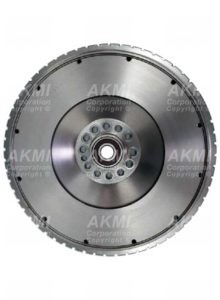Flywheels and flexplates are often confused, but they serve distinct purposes in different transmission systems. While both are crucial for transferring engine power, their design and function vary significantly, especially concerning automatic transmissions. This article delves into the role of the Flywheel On An Automatic, specifically focusing on the flexplate.
The Flywheel in a Manual Transmission vs. the Flexplate in an Automatic
Manual transmissions utilize a robust flywheel attached to the crankshaft. This flywheel engages with the clutch disc, facilitating gear changes by interrupting power flow when the clutch pedal is depressed. The flywheel’s substantial weight and durable construction are essential for smooth operation and longevity.
Automatic transmissions, however, operate without a clutch pedal. Instead, they employ a torque converter and a flexplate. The flexplate, a thinner and more flexible counterpart to the flywheel, connects the engine’s crankshaft to the torque converter.
The Role of the Flexplate: The Flywheel on an Automatic
The flexplate, essentially the flywheel on an automatic transmission, plays a critical role in power transfer. Unlike the solid flywheel in a manual transmission, the flexplate’s flexibility allows it to absorb vibrations and variations in engine speed. This is particularly important in automatic transmissions due to the fluid coupling of the torque converter.
The flexplate’s design incorporates a ring gear for starter engagement and a series of precisely machined holes for mounting to the crankshaft and torque converter. These holes are strategically placed to ensure proper balance and alignment within the system. Different vehicle and engine configurations require specific flexplate designs to optimize performance.
Regardless of vehicle size, the presence of a flexplate indicates an automatic transmission. If your car shifts gears without requiring manual clutch operation, your vehicle utilizes a flexplate for power transmission.
Flexplate Damage and Replacement
A damaged flexplate can lead to significant drivability issues and should be addressed immediately. A cracked flexplate can produce noticeable noise and vibrations, potentially causing catastrophic engine damage if ignored.
While the cost of a flexplate replacement varies depending on the vehicle and part quality, it’s a crucial investment for maintaining the functionality of your automatic transmission. Replacement typically involves removing the transmission to access the flexplate.
In conclusion, understanding the difference between a flywheel and a flexplate is crucial for anyone working with or owning a vehicle. While a traditional flywheel serves manual transmissions, the flexplate acts as the flywheel on an automatic, enabling smooth and efficient power transfer. Regular maintenance and prompt attention to potential issues will ensure the longevity and reliability of your automatic transmission system.

